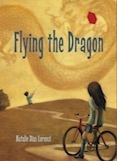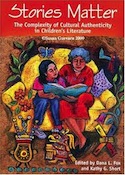By Yoo Kyung Sung, University of New Mexico, Albuquerque
 December is not only the last month of the calendar year, but it also holds a special significance for academia as it marks the end of yet another semester. Most importantly, though, December is a time for reflecting upon the past year’s events and for valuing family, friends, and other acquaintances in our lives. I thought, then, I would ask myself what I recall that was most interesting, delightful, and even troublesome in terms of children’s literature around the world. What stands out for me is cultural authenticity — the trendy hot key phrase of the 90’s that, while seeming to have become a semi-retired hot issue, still remains an unresolved tension in children’s literature today.
December is not only the last month of the calendar year, but it also holds a special significance for academia as it marks the end of yet another semester. Most importantly, though, December is a time for reflecting upon the past year’s events and for valuing family, friends, and other acquaintances in our lives. I thought, then, I would ask myself what I recall that was most interesting, delightful, and even troublesome in terms of children’s literature around the world. What stands out for me is cultural authenticity — the trendy hot key phrase of the 90’s that, while seeming to have become a semi-retired hot issue, still remains an unresolved tension in children’s literature today.
 One of the few professional books that discusses cultural authenticity and children’s literature in depth is Stories Matter (2003) by Fox and Short. In this book, a wide range of authors participate in a dialogue on the complexity of cultural authenticity. Many of those articles were published originally in the 1990’s, but the number of studies on cultural authenticity in children’s literature has gradually decreased over the last decade. However, the arguments in each chapter from Stories Matter (2003) regarding cultural authenticity are still germane since those issues keep coming back. It makes me wonder why the discussion about cultural authenticity in multi-cultural children’s literature from an insiders’ point of view has moved too easily into “the past,” evolving as in a “been there, done that” discussion. It is somewhat like looking at Richard Simmon’s aerobic class as history when comparing it to a popular contemporary fitness class like Zumba.
One of the few professional books that discusses cultural authenticity and children’s literature in depth is Stories Matter (2003) by Fox and Short. In this book, a wide range of authors participate in a dialogue on the complexity of cultural authenticity. Many of those articles were published originally in the 1990’s, but the number of studies on cultural authenticity in children’s literature has gradually decreased over the last decade. However, the arguments in each chapter from Stories Matter (2003) regarding cultural authenticity are still germane since those issues keep coming back. It makes me wonder why the discussion about cultural authenticity in multi-cultural children’s literature from an insiders’ point of view has moved too easily into “the past,” evolving as in a “been there, done that” discussion. It is somewhat like looking at Richard Simmon’s aerobic class as history when comparing it to a popular contemporary fitness class like Zumba.
About two months ago I received a brand new chapter book, Flying the Dragon (2012) by Natalie Dias Lorenzi. A beautiful gigantic dragon image is permeated with orange color pencil sketches with a yellow sky backdrop on the book cover. Under the dragon, a boy is flying a red kite, a vivid deep red as dried cranberries kite in a bowl of mixed greens. In the foreground, there is a girl sitting on a bike at rest. When I glanced at the cover I made a quick inference, “Dragon, a red kite…a new book about China?” I was wrong. It was about two cousins, one Japanese-American and the other a recent Japanese émigré, who both struggle navigating the new multi-cultural community their families created. As I started reading, I noticed a gnawing internal struggle that required periodic respites reminiscent of the critical water breaks I take while kickboxing. From the beginning, the story created a dichotomy between the aesthetic pleasure a story should bring and the doubts that arose concerning the authentic representation of Japanese culture. I kept returning to the title, Flying the Dragon. Dragons are cultural icons associated with Asian societies. They are also used, too commonly, as a misleading “Tossed Asian Salad” effect in multicultural children’s literature. Notably, depending on the looks, dragons are portrayed differently in Asian cultures and Western fantasy. Don’t get me wrong. I know I am not an insider for contemporary and traditional Japanese cultures. Yet, this book created significant cultural doubts in my mind, even though my experiences and knowledge of Japanese language and cultural practice are limited.
This month I will revisit my understandings of Asian cultures and cultural authenticity by examining my own aesthetic responses related to the critical the reading experiences utilized in several book reviews. In my reviews the critical importance of cultural representation, including portrayals of people who have culturally identified differences and similarities to the reader, mirrors the relationship between my aesthetic reading experiences and my satisfaction from critical reading. The book reviews I wrote for WOW Review are of the Chinese-American children in The Great Wall of Lucy Wu (Shang, 2012), of a Chinese family in A New Year’s Reunion (2011, Li-Qiong), and of an Indian-American child in The Grand Plan to Fix Everything (Halpin, 2012). I also revisited my annotations from the 2012 Notable Children’s Literature in Language Arts to examine what my thoughts were as I wrote it. In that critique I reviewed Inside Out and Back Again ( Lai, 2012), a story about a Vietnamese immigrant. Using those reviews as contexts, I will analyze Flying the Dragon (Lorenzi, 2012) in terms of the cultural concerns I have and the contributions Flying the Dragon may make in terms of cultural authenticity and Asian cultures.
I also want to explore classroom activities in which I invited my students to take a cultural insider’s position using local literature about New Mexico, The Land of Enchantment. I designed to encourage aesthetic responses around culturally authentic and inauthentic representations of New Mexico by thinking about how the local community here in New Mexico is represented in children’s literature.
-Reference-
Fox, D. L., & Short, K. G. (2003). Stories matter: The complexity of cultural authenticity in children’s literature. Urbana, Ill: National Council of Teachers of English.
Journey through Worlds of Words during our open reading hours: Monday-Friday, 9 a.m. to 5 p.m. and Saturday, 9 a.m. to 1 p.m. To view our complete offerings of WOW Currents, please visit archival stream.
- Themes: Yoo Kyung Sung
- Descriptors: Debates & Trends, WOW Currents
